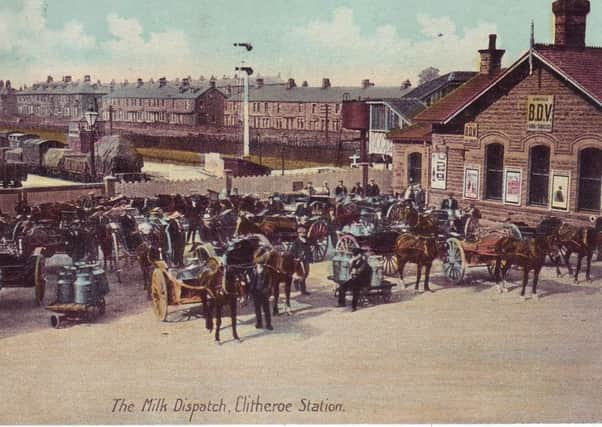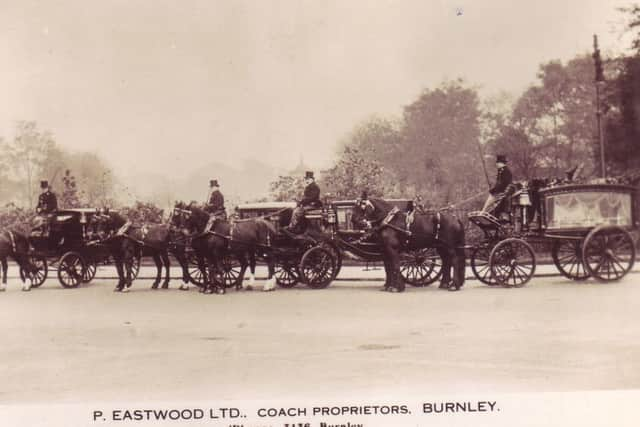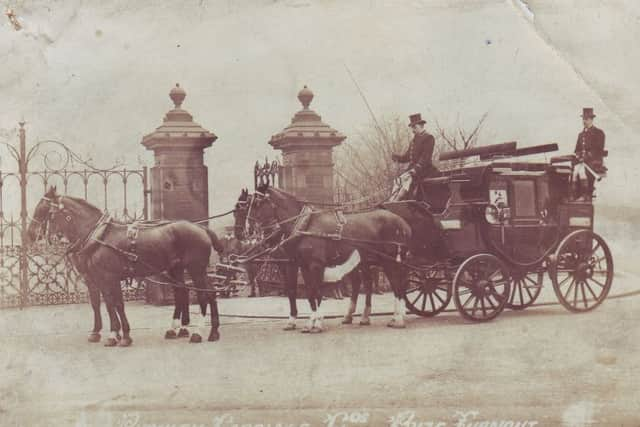Days when the horse was supreme in Burnley


Of course, despite what you might think, I cannot go back that far. However, I can recall the days when a number of milk floats were drawn by horses and the rag and bone men usually had a horse and cart as they made their way through the streets announcing their presence with a cry loud enough to pierce even the most insulated of kitchen walls.
Titus remembered the stone drinking troughs, stables, cart sheds, hay lofts and, as he put it, the “steaming middens”, which could be found all over town. In Titus’ day there were lots of very different horse drawn vehicles plying Burnley’s streets – fish carts, the similar vehicles used by sellers of fruit and vegetables, the horse drawn vehicles (lorries, wagons, canvas covered vans and box carts often) of the railway company.
Advertisement
Hide AdAdvertisement
Hide AdIn fact the latter, the Lancashire and Yorkshire Railway Co (the L&Y for short), had huge stables on Curzon Street, opposite the Bank Top, otherwise known as Central Station, though there were premises for horses on the other side of the road as well. These buildings housed the great shires, as Titus called them, and the Clydesdales which handled the heavy traffic of which there was a lot in Burnley.


In the 1950s he walked through the remains of these stables. “They had cobbled floors, row upon row of stalls, salt glazed mangers, wrought iron hay racks, ingenious mechanisms for tethering the horses with a rope, pulleys and counterweights and, above all, great empty hay lofts”.
Titus observed that his visit was like a journey back into a lost era, and he continued the theme when he added references to Burnley Carriage Co in Adlington Street and Peter Eastwood’s in Plumbe Street. These firms, for the main part, were cab proprietors but also had beautifully made funeral hearses which could be hired out when needed. Then there are references to the “black maria” operated by the police and the horse drawn steam fire engines of Burnley’s Manchester Road fire station.
Reading Titus’s article again (it was published as long ago as 1980) I began to notice all the traces of Burnley, in the age of the draft horse, had not been consigned to history. The occasional horse trough can still be found, like the one above the Roggerham Gate Inn, Briercliffe. There is an even better one on Back Lane, above Thursden.
Advertisement
Hide AdAdvertisement
Hide AdA few of the Victorian mill buildings still have their stables intact. The one at Queen Street Mill in Harle Syke, is now part of the offer at the museum itself. The stables there have been beautifully restored with boskins which came from a property at Low Sym, the originals went into the Manor Barn, which was in Padiham Road, though they appear to have been lost when that building was demolished.


Perhaps one of the more impressive of the stable buildings to survive is that at the Canal Wharf in Manchester Road. They are built of brick and have been used as offices in recent years but they are more or less intact, at least externally. I have also noticed a few of the stables and coach houses of some of our larger residential properties have survived, often made into attractive dwelling houses.
A number of the local pubs still contain references to their reliance on the horse. This can be seen at the Old Red Lion, at its Manchester Road elevation, and at the Cross Keys in St James’s Street, to name but two.
If I had a really good look around I am sure I would be able to come up with many more remains of the days when the horse was supreme. If you know any, please let me know. Better still take a photo and send it to me with a description of what it is and where it is. I have not mentioned any of the remaining farm buildings but I suspect these might be a lucrative source of information.
Advertisement
Hide AdAdvertisement
Hide AdThis column, with your help, could become a means by which we inform each other of what we know about Burnley, its heritage and history. It is something I have long wanted it to be and I would be pleased to hear from you.
You will have noticed that, today, this article is illustrated with three pictures, which illustrate how horses were used in the past. I have cheated a bit with the first as it is of Clitheroe, rather than Burnley, but it is such a good picture I thought you would like to see it.
The image is taken from a postcard posted in 1920. It is entitled “The Milk Dispatch, Clitheroe Station” and I suspect that what you can see took place on almost a daily basis up to the early years of the last century. There are so many horses and carts present, together, with their milk kits, I can’t count them all. Perhaps what is happening is that locally produced milk is being sent by rail to one of the larger towns, Blackburn or Preston, maybe? But it makes a good picture, doesn’t it? I wonder if there is the equivalent for Burnley?
I have published the second image before. This is entitled, “Burnley Carriage Cos., Prize Turnout” and the photo was taken at the original main gates to Queen’s Park, Burnley. This is a four-horse turn out and Mr Thornber had a similar photo as part of his 1980 article. The image I publish, and Mr Thornber’s, are not the same but they may be of the same vehicle which Mr Thornber dates as being “about 1895”.
Advertisement
Hide AdAdvertisement
Hide AdI have the 1896 Barrett’s Directory for Burnley (a recent acquisition) and it tells me Burnley Carriage Co. Ltd, operated as a livery stable proprietors, coach builders, carriers and furniture removers of 44a St James’s Street and Plumbe Street; Richard Dickinson, managing director.
More interestingly, perhaps, I have a copy of the Prospectus of the Burnley Carriage Co Ltd which dates from 1874. I will not go through all the technical information but it tells us who it was that came together to form the company. The directors are given as William Tillotson, a picker maker of 35 Standish Street, Burnley; Alexander Bell, the brewer of Barrowford, who had several pubs in Burnley; Joseph Crossley Jun, wholesale fruit and potato merchant of Coal Street, Burnley, and Pasture Gate Farm; Richard Dickinson, who, in 1872, was described as a grocer of 8 Howe Street, Market Place and coach and cab proprietor of Turf Moor; Mr Thomas Hargreaves, a corn and provision merchant of 15 Church Street, Burnley; Mr James Sutcliffe of the Bull Hotel, Burnley; Mr Robert Watterson of the White Lion Inn, Burnley, and Joshua Rawlinson, who was a commission agent of Hargreaves Street, Burnley.
That list tells you almost all you need to know of the origins of the Burnley Carriage Co. All of those who appear on it had an interest in efficient local transport. Richard Dickinson had run his own private carriage company and Thomas Hargreaves was a supplier of animal feed. Mr Tillotson became involved, if he was not already the case, in the transport industry and the two hotel and inn owners relied on good road transport for much of their custom.
The prospectus gives some details about the nature of the business that was envisaged – the provision of livery stables, the operation of carriages, omnibuses and cabs, and the provision of an undertaker business. The company would also operate as general carriers. It also acquired the horses, omnibuses, carriages etc of eight other companies including that of Richard Dickinson who would become managing director of the new company.
Advertisement
Hide AdAdvertisement
Hide AdThe third image is taken from an undated postcard published by Lilywhite Ltd of Sowerby Bridge. It is clearly intended to advertise the business of Peter Eastwood Ltd, Coach Proprietors of Burnley. Peter Eastwood appears in the 1883 Commercial Directory as a livery stable proprietor of Bank Parade, Burnley. His actual address was 37 Bank Parade which puts his livery stable close to the huge Keighley Green spinning mill, but, in 1896, we find him described as a mineral water manufacturer and livery stables proprietor of Cooper Street (which was off Finsley Gate) and Mitre Yard (which was off Trafalgar Street). He lived at 100 Manchester Road.
By 1914, which about when I expect the photo was taken, Peter Eastwood Ltd was described as a “carriage and motor proprietors and funeral undertakers; stables and garage, Copper Street. Registered office 8 Manchester Road”. There were also branches in Brierfield and Colne.
Lastly, there is what Burnley Civic Trust hopes will be a permanent memorial to Eastwoods on the gable wall of the Swan Hotel, St James Street, Burnley. The image you see there comes of the days of the motor coach but Eastwood’s were founded, like many of Burnley’s transport companies, in Victorian times, when, as Titus put it “the horse was supreme”.